Previously, we summarized a list of best home media server options for multi-device streaming needs. Plex was on top of that list but not everyone uses Plex and so you may have decided to use one of the alternatives.
These free media servers are great for content you already own. What if you are looking for the best free media server that is also able to handle Live TV? [Read: 10 Best Free Video Proxy Sites for Live Streaming]
While many media servers can handle Live TV using an attached TV tuner (let's call these TV servers, not all of them may do it well or to your liking.
In this article, we are going to talk about the best TV server options available for you to get your live TV on the go. More specifically, we are going to talk about various media servers and their TV tuner support.
Table of Contents
- What is a TV server?
- What is a Client for Live TV Server?
- Best TV Server Apps
- 1. Jellyfin - The Free Software Media System
- 2. NextPVR - Whole home DVR
- 3. MediaPortal - The Open-Source Media Center
- 4. Serviio - Media Streaming Server
- 5. OSMC - Open-Source Media Center
- 6. LibreELEC - Just Enough OS for Kodi
- 7. Kodi Media Center
- 8. TVHeadend - TV Streaming Server and DVR
- 9. VideoLAN VLC Media Player
- 10. MythTV - Free and Open-Source DVR
- Best Premium Media Servers for TV
- FAQ
- Final Thoughts on Best TV Server
What is a TV server?
A TV media server is used for streaming Live TV to various client devices within a network. The primary functions of a TV server are content management, streaming, recording, delivering requested content and playback to client devices.
Some of the top TV servers handle things like media transcoding and compatibility between devices or converting video formats to ensure smooth playback on the client device. Many media servers for Live TV also come equipped with an electronic program guide with metadata for easy browsing. Some TV server software includes Network-based Digital Video Recorder (nDVR) capabilities, allowing users to record and store content on the server for later playback.
What is a Client for Live TV Server?
A TV server client is an app or hardware device, or both. Various apps like Kodi and VLC can be used as a frontend for media servers that only provide a backend. Various apps can be used to view TV channels, usually known as IPTV for Internet Protocol TV. [READ: Complete Plex IPTV Guide [2021]: IPTV on Plex still works].
A hardware client is a streaming device with apps for the TV server software you are using. You can read about some suggested client devices from previous articles I have written.
- 10 Best Plex Client Devices [2022] – STUTTER-free Streaming
- 10 Best Emby Client Devices [2023] – 4k, Hardware Transcoding, etc.
- 10 Best Jellyfin Client Devices [2022] – 4k, Hardware Transcoding, etc.
When choosing a client device, it is important to make sure it is supported by client apps. You can do this by checking the appropriate app store online or doing a little research. Some software servers have their own apps while some rely on third-party solutions (e.g. Serviio).
Best TV Server Apps
This article primarily focuses on free Live TV streaming servers. But we will cover a few of the great paid options as well.
1. Jellyfin - The Free Software Media System
Jellyfin is the free software media system built by volunteers to put you in control of your media. With Jellyfin you can stream to almost any device.
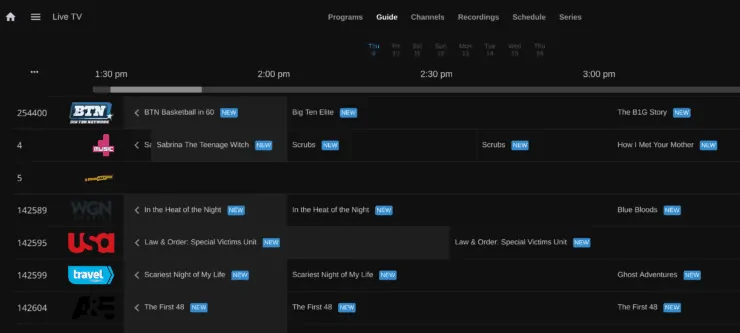
All kinds of plugins are made for Jellyfin to provide metadata and artwork for your entire collection of movies, TV shows and music. [Read: 15 Best Jellyfin Plugins [2022] – Supercharge your Media Server.]
You can record and collect your favorite TV shows, and Jellyfin will automatically organize them by season and episode. You can also watch live TV and schedule automatic recordings to add to your collection while you are away from your TV.
Jellyfin also allows you to watch your media from a web browser on any operating system. Jellyfin also supports AirPlay and Chromecast. There are various client apps on Google Play and Apple App Store. There is even an official Jellyfin Roku client, which we have reviewed in the past.
With a lot of control over customization and plugins, Jellyfin is the best TV server for tinkerers. Jellyfin supports the following TV tuners:
2. NextPVR - Whole home DVR
NextPVR is a free personal video recorder for Windows. It allows users to record live television from compatible TV tuners and provides features like time-shifting, scheduling recordings, and managing a digital video library. NextPVR also supports a variety of TV tuner cards and hardware, making it versatile for different setups.
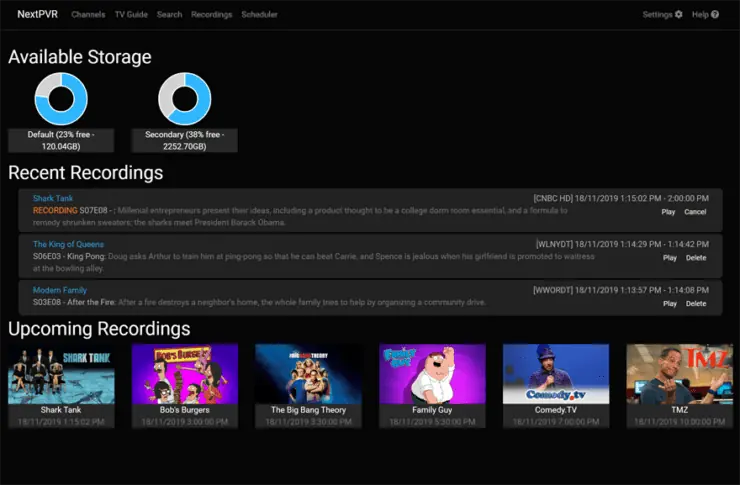
NextPVR lets you watch and pause live TV, as well as rewind and fast forward during playback, similar to a traditional DVR. Users can set up schedules to automatically record their favorite TV shows or specific programs, even when they are not at home. It retrieves program guide data to display upcoming TV schedules, making it easier to find and schedule recordings.
Recorded TV shows are organized in a library, where users can manage, categorize, and watch them at their convenience. Support for multiple TV Tuners. NextPVR is compatible with various TV tuner types, such as analog, digital (ATSC, DVB-T, DVB-S, etc.), and IPTV. With support for plugins, allowing users to extend its functionality or integrate it with other applications.
3. MediaPortal - The Open-Source Media Center
MediaPortal is a great TV server solution optimized for Windows. Hundreds of plugins and skins allow you to personalize your experience with the MediaPortal Configuration program. MediaPortal plugins are fully integrated and installing skins is easy using MPEI, the MediaPortal Extensions Manager.
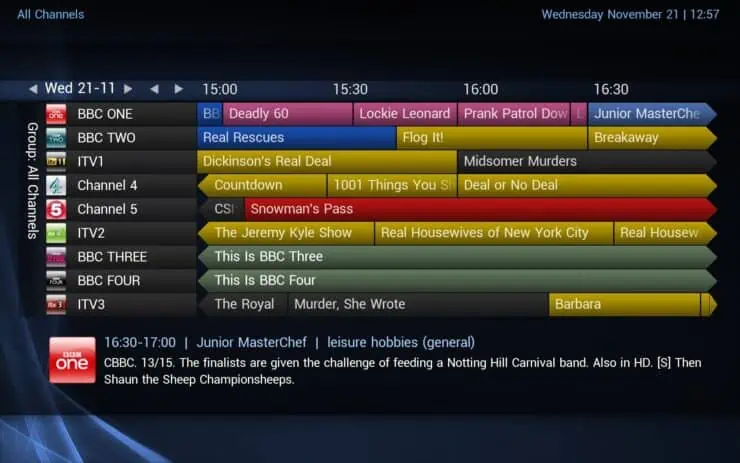
MPExtended lets you access MediaPortal remotely. MediaPortal is also compatible with apps like Plex clients to tap into features from client devices.
The WifiRemote plugin allows clients such as an Apple iPhone, Android phone or tablet to list and connect to all MediaPortal installations on a network.
MediaPortal has a TV Engine and PVR that allows you to record shows from the TV Guide. You can also add EPG metadata from your TV Card/FM Tuner, DVB tuner signal, or Radio EPG.
You can view RSS news feeds. The MP weather section gives you 5-day weather forecasts. You can even access Wikipedia pages (with images) from inside MediaPortal.
MediaPortal provides a whole-house media solution for live TV, which includes sharing TV tuner resources to multiple client devices on a home network.
4. Serviio - Media Streaming Server
Serviio is a free TV server that also offers a pro version. With its own Alexa Skill for voice commands, Serviio Media Server is one of the best TV servers available for Windows, Linux, and Mac operating systems or QNAP and Synology NAS devices.

It can stream audio, SD and HD video and image files in their native format or real-time transcoding from RSS/Atom feeds, live streams and content embedded on a web page. You can play internet radio stations, SHOUTCast streams, and live TV.
What makes Serviio one of the best TV servers for techies is custom renderer profiles. Serviio allows you to create renderer profiles for rendering devices. Using the profiles definition file is config/profiles.xml, Serviio allows you to create new profiles in config/user-profiles.xml.
You can use VLC to stream live TV with Serviio.
5. OSMC - Open-Source Media Center
OSMC is among the best TV servers as a Debian-based Linux distribution that boots directly to Kodi Media Center. With OSMC it is easy to get started right away with very little tinkering.
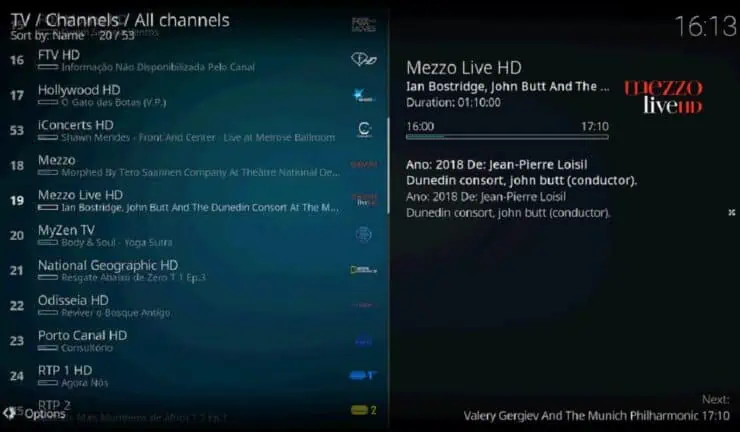
Vero 4K + is OSMC's flagship device. Vero can play anything you need to play with support for 4K, HEVC, 10-bit content and HD audio. OSMC also manufactures and sells an official DVB-T2 dongle suitable for terrestrial OTA TV.
Another great feature is OSMC supports a great number of hardware remotes, which you can select from a gallery of remotes and set as your default remote. OSMC also supports CEC, which gives you hardware remote control over OSMC with your existing TV remote.
To run OSMC on Android, your best option is the Vero 2 or higher. My recommendation is the Vero 4K+. But you can also build a Raspberry Pi media center with OSMC. I recommend the Raspberry Pi 4 with 8GB of RAM. [Read: 8 Amazing Raspberry Pi Ideas [2022]: Beginners and Enthusiasts]
TV tuner support for OSMC is supported by the underlying operating system, which is Debian-based Linux. Most TV tuners are supported out-of-the-box or have a distro repo package. OSMC allows you to install distro repo software to support your TV tuner.
6. LibreELEC - Just Enough OS for Kodi
LibreELEC is a Kodi-embedded distro based on Debian Linux. It makes using Kodi easy and provides many add-ons so you do not have to "do-it-yourself", using Docker images from LinuxServer.io for extra features. You can install any PVRs you want on LibreELEC in the form of Docker applications.
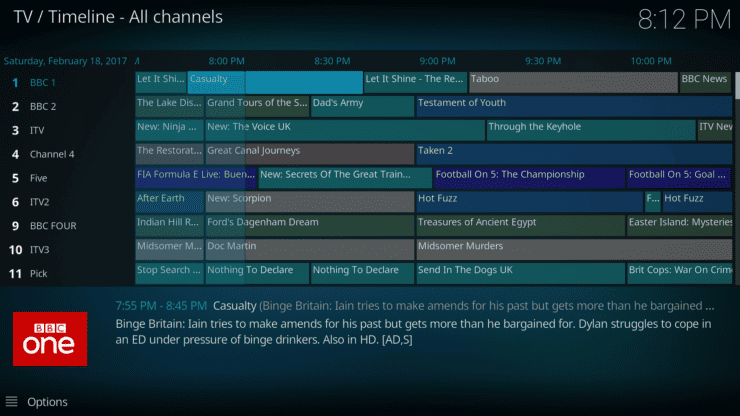
That is the way it is done on LibreELEC because it is installed on a read-only filesystem.
LibreELEC is lightweight and easy to setup, gets regular updates to keep it stable and secure, and provides extensive add-on support at the same time this way. Not only that but LibreELEC supports a wide variety of TV tuners. Also, if you install a tuner that is not supported by Kodi or LibreELEC (Debian), it may be possible to install a PVR add-on that does as a Docker app.
TV tuner support for LibreELEC is supported by the underlying operating system, which is Debian-based Linux. Most TV tuners are supported out-of-the-box.
7. Kodi Media Center
Kodi Media Center (formerly XBMC) is an application made for streaming all kinds of media formats, capable of a wide range of playback options. Kodi supports a great diversity of technologies natively and allows for add-ons to create even more compatibility and functionality. This makes it one of the best TV servers of all time.
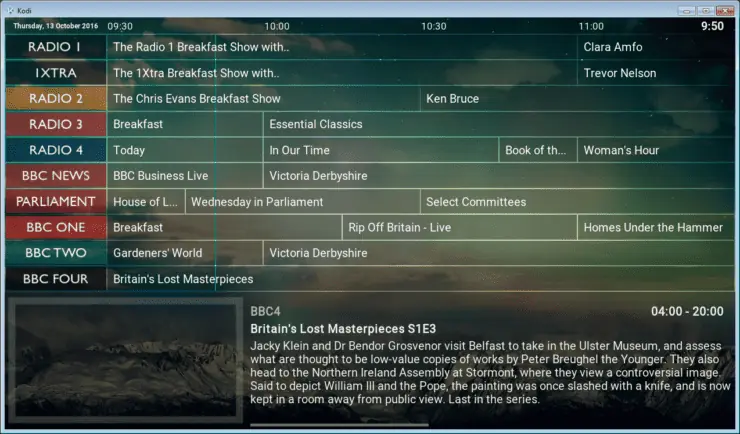
Though technically you must configure Kodi to be a server, using a PVR backend turns it into one instantly. You can run Headless Kodi with a bit of knowledge and effort, which means you do not even have to use the GUI. You can simply run Kodi to serve up the PVR and, of course, all the great TV.
Not only can you add a PVR to Kodi, but you can configure more features to use along with a PVR. For instance, you can install and configure an add-on to create an EPG of your choosing rather than one made for you. You can even set up your own metadata sources for an EPG using a commercial subscription with an add-on for EPG.
I recommend TV Guide Fullscreen with Plex and XMLTV guide source.
TV tuner support for Kodi relies on what operating system you are on. As long as the TV tuner is recognized, you can watch TV inside Kodi. Linux supports most TV tuners natively. You should check the documentation for your TV tuner on a Linux distro.
8. TVHeadend - TV Streaming Server and DVR
TVHeadend is a free and open-source TV streaming server and digital video recorder (DVR) software designed for Linux, FreeBSD, and other Unix-like operating systems. It serves as a backend system for managing TV tuner support, recording, and streaming of live TV broadcasts.
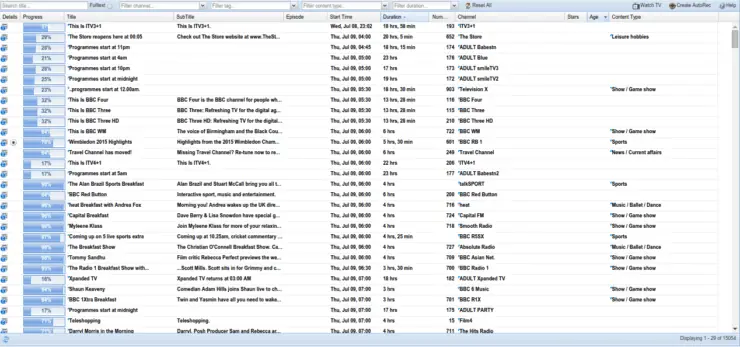
TVHeadend is primarily used in combination with frontend media center applications like Kodi to provide a comprehensive media center experience. It supports a wide range of TV tuner cards and devices, including DVB-S (satellite), DVB-C (cable), DVB-T (terrestrial), and ATSC tuners, allowing users to access and watch digital TV channels.
TVHeadend uses Electronic Service Guide (ESG) data for additional program metadata and information. TVH also integrates with EPG data providers to give users an EPG for upcoming TV programs and for scheduling recordings.
TVH can stream live TV broadcasts to various devices and media players, allowing you to watch TV on many devices simultaneously. It supports time-shifting, enabling users to pause, rewind, and fast-forward live TV.
With a user-friendly web interface for configuration and management, users can access and control the server from any web browser. It can transcode TV streams into various formats, so it is possible to watch TV on devices with different playback capabilities.
Like Kodi, TV tuner support for TVHeadend relies on what operating system you are on. As long as the TV tuner is supported, you can install your TV tuner hardware.
9. VideoLAN VLC Media Player
VideoLAN's VLC is a free and open-source software available for various platforms, including Windows, macOS, Linux, and mobile devices. VLC media player also supports TV tuners. As a versatile multimedia player, it supports a wide range of audio and video formats.
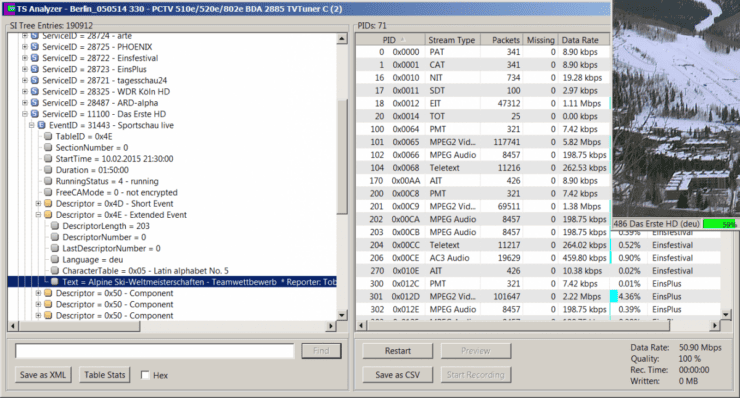
In addition to playing media files, VLC has features for live TV streaming and TV tuner support. You can use your computer's TV tuner card or a USB TV tuner to watch and record live TV channels directly within VLC. This feature allows you to turn your computer into a digital TV server using VLC for TV viewing.
To install a TV tuner in VLC, go to View > select Playlist and click on Internet. Select your TV tuner option and start streaming. As long as your TV tuner is installed and using the appropriate firmware, VLC will find it. Linux (particularly Ubuntu) supports most modern TV tuners out-of-the-box.
You should reference the hardware compatibility list for VLC before buying.
10. MythTV - Free and Open-Source DVR
MythTV is a free and open-source DVR and media center designed for Linux. It is the easiest way to convert your computer into an HTPC made for TV, allowing you to watch and record live TV, manage your media library, and access media content.
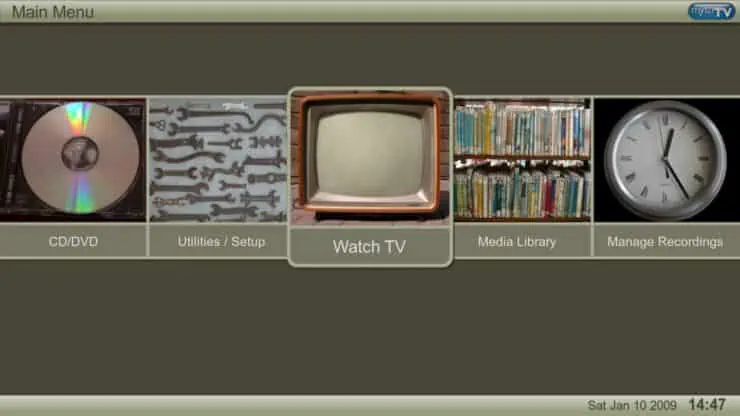
It supports a wide range of TV tuner cards, including DVB-S (satellite), DVB-C (cable), DVB-T (terrestrial), and ATSC tuners and features time-shifting capabilities, allowing you to pause, rewind, and fast-forward live TV. It integrates well with EPG metadata services to view upcoming TV programs and schedule recordings.
MythTV provides the ability to stream live TV and recorded content to other devices on your home network. It is designed to work with remote control devices, making it convenient for use in a living room or home theater setup. It also supports a vast array of plugins and extensions, enabling users to expand its functionality and integrate with other services and devices.
Think of MythTV as an alternative to Windows Media Center or Tivo. Once it was its own Linux distro that would boot to a minimal TV server interface, but today it is available on every Linux distro as a software package. You can install a minimal Linux operating system and run it as a MythTV server.
MythTV is the best TV server if you want complete freedom to control the underlying Linux operating system. With all the open-source multimedia applications available in a Linux distro you can add all kinds of other features and apps and even other server software to improve your setup. There is no end to what you can do with MythTV in combination with other multimedia apps on a Linux OS.
Best Premium Media Servers for TV
Here are some good options if you don't mind spending a little money. Plex Media Server is a monthly subscription. Emby also requires a sub for live TV. Jriver allows you to buy a license once. Honestly, I like one-time payments more and more these days!
11. Plex Media Server
Plex Media Server is a popular media server to organize, stream, and access content from various devices. It runs on your computer or NAS and many other types of devices. You can easily run a TV server with PMS and Plex Pass, a subscription that costs $4.99/month.
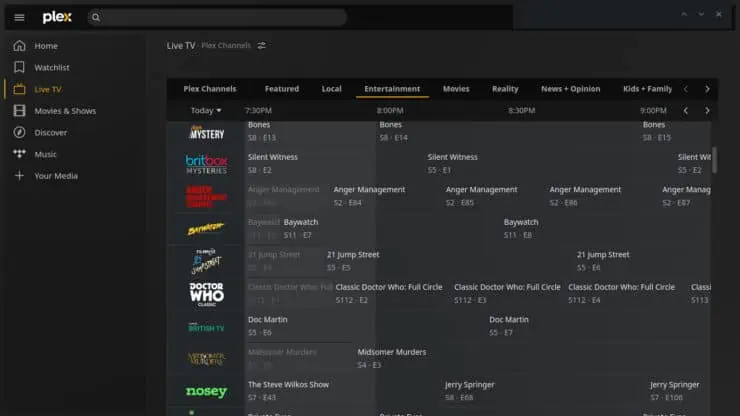
A subscription is required if you want live TV. Plex automatically organizes your media files (movies, TV shows, music, photos, etc.) and fetches metadata from various online sources. Plex allows you to access your media remotely over the internet, making it convenient to enjoy your content while away from home.
Plex can be easily installed using Docker compose and with the right Plex hardware or a compatible NAS model, Plex supports most file formats and codecs. When streaming media, it can transcode the content on-the-fly to ensure for the client device.
If the client device can handle the media format directly. Plex uses a thing called "Direct Play," to avoid transcoding and minimize server load. [Read: 10 Best Plex Client Devices – STUTTER-free Streaming]
Plex offers a feature to watch and record live TV, turning your PMS into a software DVR where you can schedule your recordings.
12. Emby - Take Your Media Anywhere
Emby is also one of the best TV servers and probably the most well-known before Jellyfin. With all kinds of great features to make viewing and managing your media easier, Emby has features that are definitely worth using.
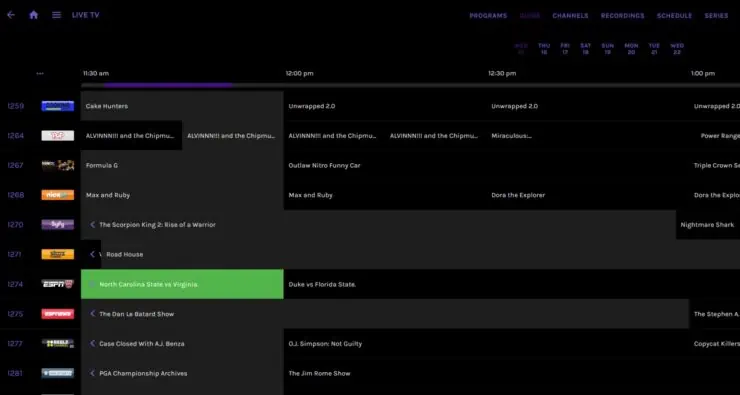
But you will need an Emby Premiere subscription to fully harness the power of Emby.
Emby supports live TV streaming to almost any client device, providing client apps for all operating systems and hardware. You can manage your DVR from inside the Emby GUI and record all your favorite shows, podcasts and radio. Unlike Plex, Emby (and Jellyfin) has no limits on channel numbers. [Read: Complete Plex IPTV Guide: IPTV on Plex still works]
Emby also has parental controls. Today not every app can say that because it seems more important than ever. You can also monitor and control viewing sessions remotely to ensure nothing is being watched that is not allowed.
Like Jellyfin and unlike Plex, web-based tools allow you to edit metadata and images, search for subtitles, and organize and manage your media files. Emby can automatically detect DLNA-enabled devices on your home network, so you do not have to configure every new device that comes and goes when someone visits with a new phone or tablet.
Emby supports the following TV tuners:
13. JRiver Media Center - The Universal Media Software
JRiver Media Center uses multiple software servers to share media between devices. Media Center zones serve media to multiple clients, even playing different media on the same device at the same time. JRiver Media Center works with smart TVs, Blu-ray players, receivers, and other devices supporting DLNA playback. You can even use a PlayStation 3 or Xbox 360 with JRiver.
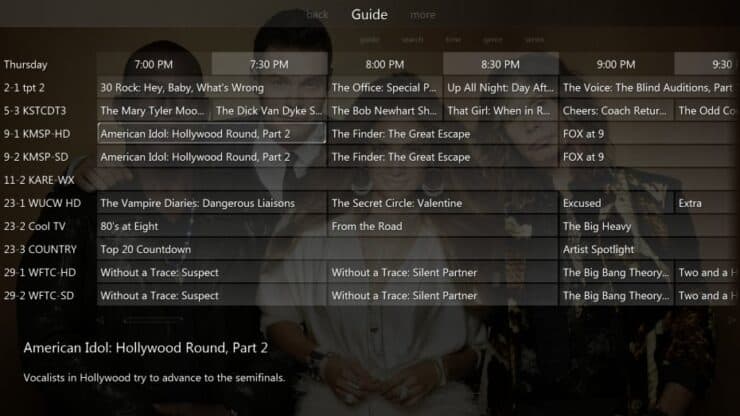
JRiver provides several software remotes, including, Gizmo, WebRemote, Jremote, Tremote, and Panel.
Video streaming from Netflix, Hulu, and YouTube is integrated natively into the JRiver Media Center interface. JRiver uses its own innovative Red October system to download, install, and configure DirectShow filters automatically. No set up required!
For Jriver support for the TV tuner comes from the underlying operating system, Windows, macOS or Linux. You should reference the documentation or wiki for your TV tuner.
Honorable Mentions
- DVBViewer - Your Software for TV and Radio
- ARGUS TV – Smart TV recording on your PC
- VDR (Video Disk Recorder)
- PotPlayer - Multimedia Player
- PseudoTV Live
FAQ
What is a server for TV?
A server for TV is a media server that supports Live TV streaming using a TV tuner hardware such as SiliconDust HDHomeRun.
How do I create a media server for my TV?
Typically, to create a media server for your TV, you will need an always running server (e.g. home server) or a network attached storage. You can then install media server apps you need, along with a supported TV tuner. With this setup you can stream stored content as well as Live TV channels.
What are various types of TV tuners?
Digital TV tuners can be USB TV tuners or PCIe TV tuners that are internal tuner cards installed on a computer's motherboard, such as ATSC (North America), DVB-T/T2 (Europe and other regions), ISDB-T (Japan and some South American countries), etc. Network-Attached TV Tuners stream TV signals over a local network. Satellite TV tuners are used to receive non-scrambled television signals from satellite providers. Cable TV tuners are for receiving non-scrambled cable television signals. Analog TV Tuners receive analog television signals but are almost obsolete because the majority of countries have transitioned to digital TV broadcasting.
What is a video capture card?
Video capture cards installed in a computer are used to capture and process video signals from various sources, such as live TV channels and TV tuners. Capture cards receive video signals from different sources, including cable TV, satellite receivers, or digital TV antennas. HDMI, component, composite, or SDI inputs allow them to connect to the output of set-top boxes and other devices. When connected to a live TV channel's output, the capture card processes the incoming video signal and converts it into a digital format that can be used by other apps.
What is a hardware PVR?
Hardware PVRs are popular among users who prefer a dedicated device for recording and managing TV content without the need for a full-fledged computer-based solution. They provide a user-friendly way to enjoy television viewing using features like time-shifted playback and often times include an EPG. Hardware PVRs also have various output options, such as HDMI or composite, to connect to TVs and other devices supporting playback. Some PVRs may also offer network connectivity to transfer recorded content to other devices or access online content.
Why not just buy a DVR?
With a PVR you still must have a tuner to watch and a tuner to record, but you can use a PVR on a standard computer. A DVR that does not allow external storage requires keeping your DVR to watch your shows. With a standard PVR you can keep what you record as long as you can store it digitally. Some DVRs that allow external storage are Channel Master, Dish Network, DirecTV, HDHomeRun, Tablo, TiVo and Xfinity X1. DVRs that do not allow external storage include AT&T U-verse, Cox Communications, Spectrum and Verizon FiOS.
Final Thoughts on Best TV Server
The best TV server is the one that you can install on an operating system you are familiar with that has a user-friendly interface and features for playback. Though some TV servers may require more configuration than others, many times this means more custom features. Depending on how much you record what you watch, you may need to add TV tuners.
It is good to ensure you are installing the backend on a device that supports the TV tuners that are compatible with your server. If you are using an internal video capture card with a built-in TV tuner, this might limit your choices or give a choice that is only available for certain apps. No matter what, it is important to do your research, so you do not unwisely invest your money.
Open-source media servers are usually free, and that makes it easy to buy new hardware. Another great thing about open-source software is that it is supported by users, which means if you don't like a feature, you can change it. If you are not a developer or coder, you can make a feature request.
The biggest challenge is using just one. They are all worth using in one context or another. Yet, you can't run a bunch of servers on one hardware device. Docker does make it possible to install many servers, however, simply because it is more efficient. Yet, even Docker is limited to the ultimate ability of the hardware to take on more tasks.



![Watch NFL Games Live FREE 🏈: 23+ WORKING websites [2023] Watch NFL Games Live FREE](https://www.smarthomebeginner.com/images/2023/08/nfl-streaming-1.jpg)
![20 Working websites to watch March Madness online FREE [2022] Watch March Madness Online Free](https://www.smarthomebeginner.com/images/2022/03/march_maddness-scaled.jpg)
![Watch College Football Online FREE [2023]: 🏈 23+ WORKING websites Watch College Football 2023](https://www.smarthomebeginner.com/images/2023/08/college-football-2023-e1692045798880.jpg)
![22 Working websites to watch College Football online FREE [2021] Watch College Football Online 2021](https://www.smarthomebeginner.com/images/2021/08/watch-college-football-online-ft.jpg)
![10 Best Plex Client Devices [2022] - STUTTER-free Streaming Best Plex Client Devices](https://www.smarthomebeginner.com/images/2022/02/best-nas-for-plex-server-featured-images-from-pexels-photography-maghradze-ph-3764958-e1648542743772.jpg)